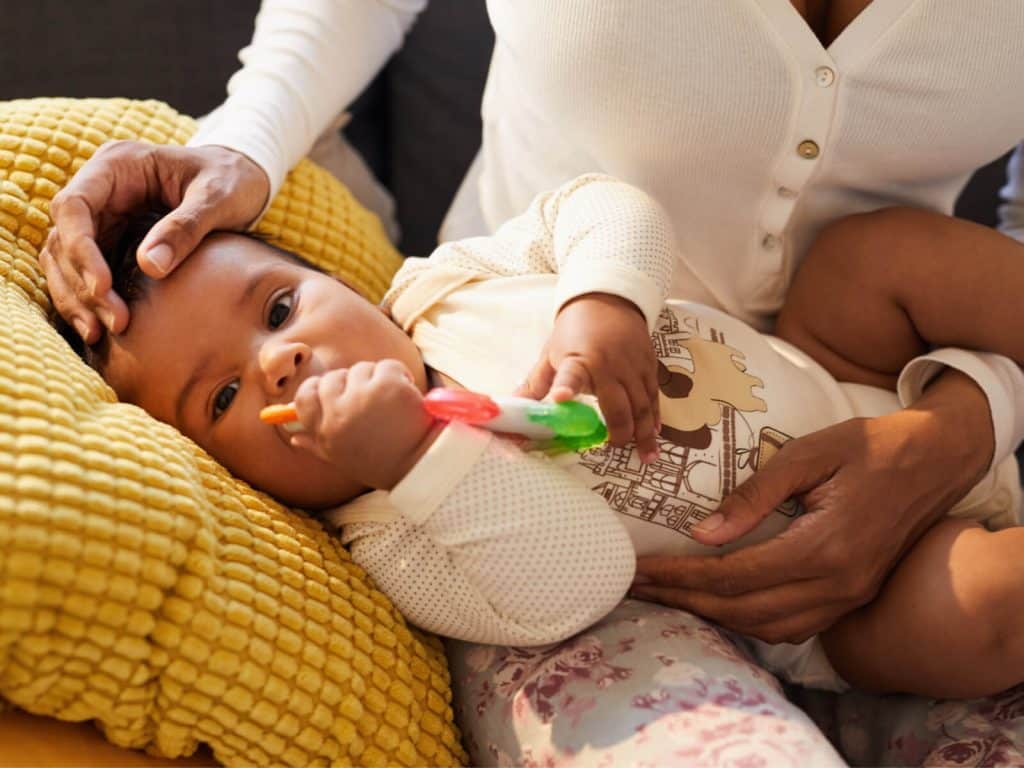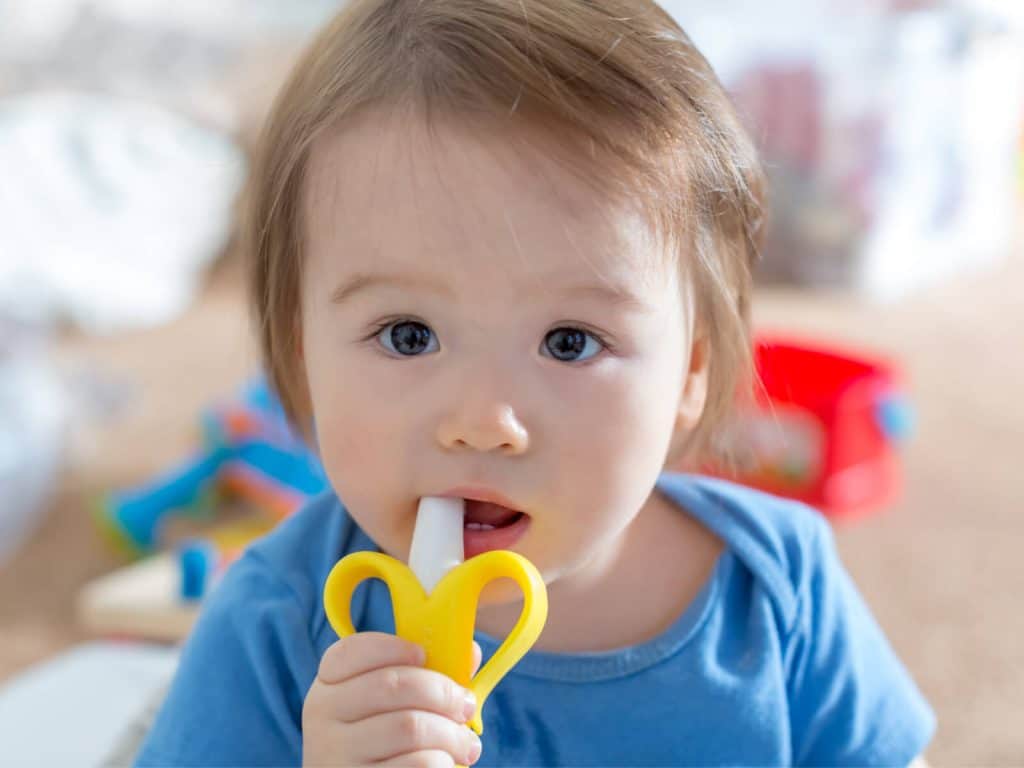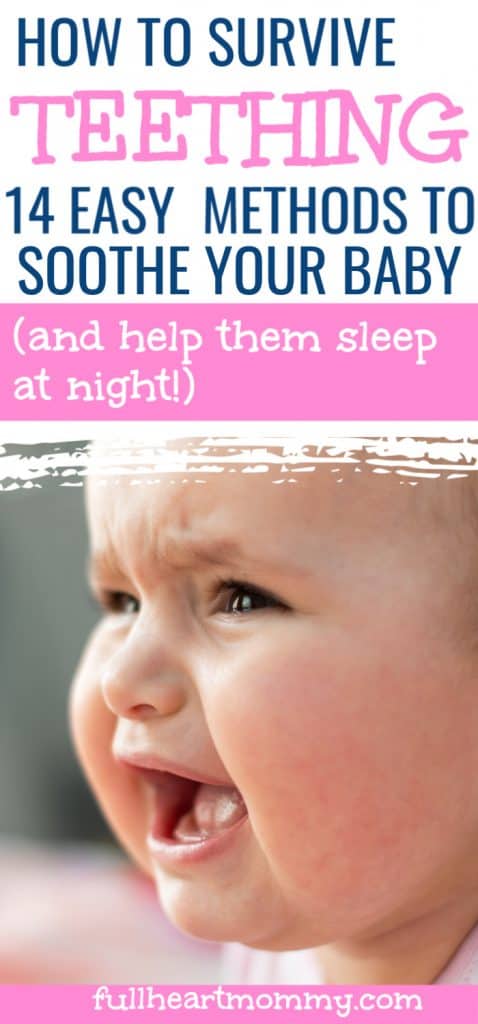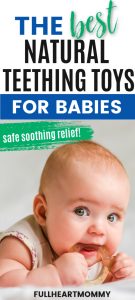Teething is an unpleasant experience for both babies and parents. While our little ones are going through new and confusing pain, we’re watching them and feeling like there’s very little that we can do to make it better!
Though it might feel like your teething baby is going through a world of pain for what seems like an eternity, it doesn’t last long and each tooth will be easier to cope with than the one before.
Figuring how to survive a teething baby does take some trial and error. While waiting for that first tooth to arrive, there are a few ways to prepare yourself for the pain of teething.
Here we will cover everything that you need to know about teething, as well as a few of the best methods to relieve your baby’s sore gums and make the process a little easier for everyone.

When Do Babies Get Teeth?
Generally, most babies will start teething at around 6 months old. There are some babies, however, that might start teething as early as 4 months old or as late as 12 months! So if those gums are the only thing on show in your baby’s first birthday pictures, don’t panic.
By around 19 months of age, children will have their first set of teeth, minus the second set of molars – these will appear between 2-3 years old. The rate at which children’s teeth come in will vary from child to child, it’s completely normal for your friend’s baby to have 10 teeth while your baby only has their bottom two teeth.
What Are Teething Baby Symptoms?

There are a whole host of teething symptoms that your baby may or may not experience. Some babies will suffer through every symptom there is, while others will breeze through teething without a care. Let’s all cross our fingers for the latter…
Here are the most common teething symptoms to look out for that might be a sign of a tooth arriving.
Irritability
If your baby is uncomfortable and you’re finding it hard to settle them, it could be due to teething. When teeth start coming through it can be incredibly unsettling for babies, and they might start getting frustrated with the pain.
Difficulty sleeping
Difficulty sleeping is another symptom linked to the discomfort caused by teething. If your baby is having teething night wakings and being woken by the pain you’ll probably find that they are experiencing other symptoms alongside difficulty sleeping.
Pulling on ears
Babies might pull on their ears when they’re teething. This might be because the pain that they feel in their gums has traveled up to their eardrums, but can also be because they think that the pain is originating from the ears.
Red cheeks
Your baby’s teeth can cause irritation which may result in rosy-red cheeks. They might also feel warm to the touch, which is normal! Just be sure to check that your baby doesn’t have a temperature and that it’s only their cheeks that are hot.
Dribbling
Teething causes the mouth to produce excess saliva that unfortunately will be dribbled all down your baby’s chin. Try to keep the area as dry as possible, and use bibs to keep their chest and clothes dry.
Rash around mouth
A rash around your baby’s mouth is most likely to be caused by constant dribble. The rash can also appear on their neck and chest.
Putting their hands and objects into their mouths
Chewing on their hands, teething toys, and other objects is common during teething as it can help to relieve some of the pressure caused by the teeth pushing through the gums.
How Long Does Teething Last?
Don’t panic, teething doesn’t last from the first tooth until the final molar! Each pair of teeth will usually cause discomfort for around 1 week – you might even notice new teeth appearing with no symptoms at all.
How To Soothe A Teething Baby

There are a few things that you can do to soothe a teething baby. Here are some of the most effective teething remedies.
Comfort
Teething babies will need lots of love and attention to make them feel better. Prepare yourself for days spent cuddling on the sofa!
Chilled fruit
Chilled or frozen vegetable sticks (like carrot and cucumber) are perfect for teething babies. They’re the ideal size for babies to grip, and the perfect shape for little gums to chew on.
Cold cloth
Put some water on a clean flannel or burp cloth, place it in the fridge, and give it to your baby once it’s nice and cool. Remember to squeeze any excess water out so that they don’t soak their clothes!
Refrigerated metal spoon
Metal spoons are great for both entertainment and teething. Place a teaspoon in the fridge until it’s cool for one of the best homemade teething remedies.
Massage
Make sure that your hands are clean and give your baby’s sore gums a little massage. They might not let you put your hands anywhere near their sore mouth, but they might also really enjoy chewing on you. Let them decide.
Dry the drool
Keep your baby’s chin, neck, and chest dry from drool to prevent further discomfort from skin irritation. Pop a bib around their neck and keep a burp cloth on hand at all times to clean up the drool.
Chilled teething toy
Get a natural teether for baby for them to have a good chew on. Remember to wash the toy frequently and keep it clean (and cool!) by replacing it in the fridge after each use.
Other Helpful Posts You Might Like:
Over the counter medications
If none of the above remedies are working, or if your baby is having particular trouble sleeping at night (we’ll cover remedies for this below), there are over-the-counter medications that you can give to your baby to help relieve the pain of teething.
How To Get A Teething Baby To Sleep
It’s important that you don’t leave your baby with teething toys and damp cloth or fabric to chew on at night as these can pose a suffocation or choking risk while you’re not watching.
Well, how to get a teething baby to sleep? Teething night wakings can be tough on both mom and baby. It’s hard seeing your baby in pain at night and you might also be exhausted from less sleep.
Here’s how to soothe a teething baby at night. These are natural teething remedies that you can use to relieve your baby’s sore gums during the night or as they go to sleep.
Pacifier
One of the BEST teething tricks is to fill a pacifier with frozen breastmilk! Breast milk is calming for babies and can relieve pain, while the fact that it is frozen will also relieve pain in the gums. To do this, use a pacifier or feeder , like this one, that can be safely filled with food , then fill the pacifier with milk before placing it in the freezer. This can be especially useful when trying to get your baby to sleep at bedtime or during the night.
Chamomile tea
Chamomile is another great natural relief for breastfeeding – it has calming and anti-inflammatory properties. It’s also a great way to keep your baby hydrated when they’re off nursing or eating because of the pain. This will be a good teething remedy if your baby is 6 months or older.
Breastfeed
Breastfeeding is comforting for irritable babies and can be a form of pain relief. Bear in mind that while teething your baby may not want to breastfeed as often as normal, and that’s ok! Just make sure that they are getting enough hydration by offering to nurse them more frequently and offering them water if they are over 6 months.
Cold food for dinner
Consider giving your baby cold and pureed food for dinner. The cool aspect will soothe their gums before they go to bed, while making it pureed will make it easier for them to eat – that way you can be sure they have gone to bed with a full belly.
Keep the room cool
Sore gums, hot cheeks, and general discomfort can cause your baby to feel overheated. Keep the room cool at night to help your baby get a good night of sleep.
Make sure you know what to dress your baby in at night for sleep so they are comfortable in addition to these soothing teething remedies.
Stick to your routine
If you have a bedtime routine in place with your baby, stick to this as much as you can when your baby is teething. Bedtime routines are a source of comfort for little ones and straying from this can make the whole teething situation even more alien to them.

“But my teething baby only wants to sleep on me!” Sound familiar?
Read to and soothe your baby to sleep as you normally would – one thing that you might have to change is staying with them for a little longer as they fall asleep.
Every child experiences teething differently, you might find that some of the above solutions work brilliantly for one child while making no difference for another. Or maybe you found one method to work with the first pair of teeth, but it doesn’t seem to be relieving the pain of the next pair.
Some parents find they make it through this time with cosleeping while teething. There’s no ONE right way to survive a teething baby.
Try out a few different teething relief methods to see what works for your child – and note that it might take a few attempts for them to get used to the new teething toy or breastmilk-filled pacifier. Give your baby a chance to get used to the method of pain relief before writing it off completely.
Good luck!



